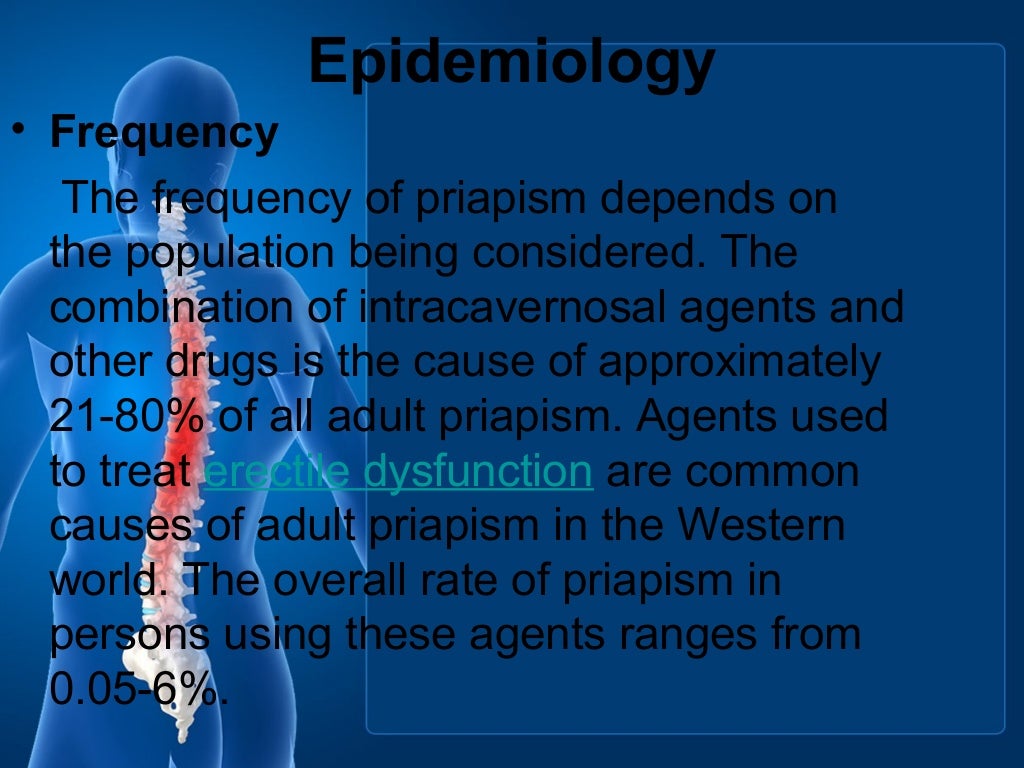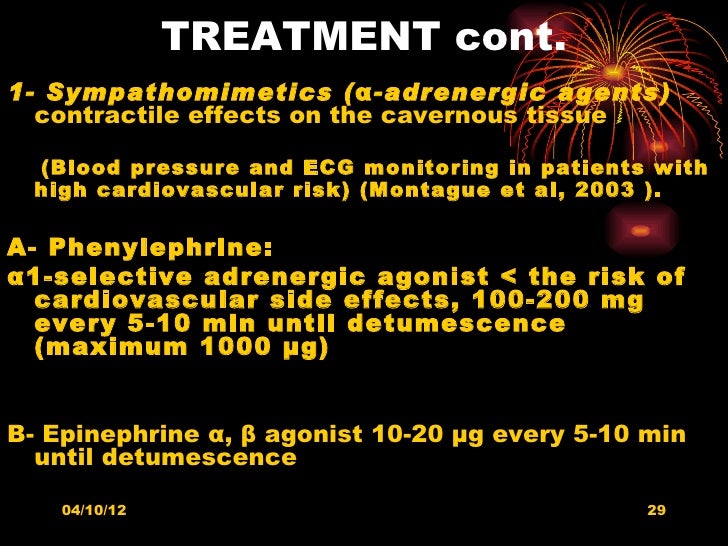Table of Content
This drug constricts blood vessels that carry blood into the penis. This action allows blood vessels that carry blood out of the penis to open up and allow increased blood flow out. You will be monitored for side effects, such as a headache, dizziness and high blood pressure, particularly if you have high blood pressure or heart disease. If you experience recurrent, persistent, painful erections that resolve on their own, see your doctor.
Studies that had a patient enrollment of ≥2 per group at follow-up . The Panel was created in 2018 by the American Urological Association Education and Research, Inc. This guideline was developed in collaboration with the Sexual Medicine Society of North America .
What is priapism?
You should know that taking stress is very harmful for priapism as it can make the condition worse. So try to find out some stress relieving activities and be stress free. Do you have morning erections, if so then it is a common phenomenon and related to full bladder. Before you sleep, you should urinate first and empty your bladder. Some reports have told that early morning erections have a chance to make you suffer from priapism. Trauma can be the other related issue that can lead to priapism.

A lab test measuring the amounts of certain gases in the blood can confirm the type of priapism. Priapism is a painful condition which can make you feel uncomfortable and unpleasant. It can be caused by direct injury to the penis, pelvis or perineum.
Guideline Statements
The degree of ischemia is a function of the number of emissary veins involved and the duration of occlusion. Light-microscopy studies conducted early on demonstrated that corporeal tissue becomes thickened, edematous, and fibrotic after days of priapism. With recurrent priapism, a patient experiences periodic erections that self-resolve, Akakpo explained. Sickle cell disease patients and people with blood disorders appear predisposed to this kind of priapism.

You should know that whenever man get aroused then the arteries in penis relax and expand which brings lots of blood flow to spongy tissues. Meanwhile, the valves in veins gets closed, gathering blood in the area and hence erection is caused. Actually, for erections to occur properly, blood flow is must and without it, there can be problem in erection. "There is no validated treatment for patients coming with stuttering priapism," Akakpo said. "The results are very good," Akakpo said, adding recovery tends to go well and there's minimal risk of developing erectile dysfunction afterward. Ischemic priapism functions similarly to a sexually stimulated erection under normal circumstances, save for the venous system closure that traps blood, he said.
What are the causes and risk factors of priapism?
This test also helps your doctor determine whether trauma or injury is the underlying cause of this disorder. This procedure involves inserting a needle into your penis and collecting a blood sample. If the sample reveals that blood in your penis is deprived of oxygen, you have low-flow priapism.

He or she might be able to determine what type of priapism you have based on whether you’re experiencing pain and the rigidity of the penis. This exam might also reveal the presence of a tumor or signs of trauma. Conditions that affect the nervous system and so indirectly affect blood flow to the penis, such as brain or spinal cord tumors or injury.
Priapism treatment
The major neurotransmitter that controls erection is nitric oxide, which is secreted by the endothelium that lines the corpora cavernosa . Diseases Treatments Dictionary Complete solution for all diseases && disorders treatments. To know any Diseases that which may it causes, symptoms on your body, and how can prevent from them, what to do on first aid, Definition’s, Diagnosis and Test, Risk Factors, specific treatments. In addition to the aspiration of the penis, a medication like epinephrine, an alpha agonist, can be administered to encourage vascular contraction to deflate the erection.

It’s more common in males who have an inherited disorder characterized by abnormally shaped red blood cells . Recurrent priapism describes repetitive episodes of prolonged erections and often includes episodes of ischemic priapism. In some cases, the condition starts off with unwanted and painful erections of short duration and might progress over time to more frequent and more prolonged erections.
This condition is known as non-ischemic and is rare compared to low-flow and is less painful. This occurs when there is any injury in penis or the area between scrotum and anus stops the flow of blood to penis from moving normally. A number of effective treatments for priapism cease to work on an erection that has persisted for more than 48 hours, he said. In ischemic cases like this, venous blood with low oxygen pools into the penis. He likened the arterial dysregulation involved in nonischemic, high-flow priapism to an open fire hydrant that can't easily be closed.
Methods of controlling thrombosis, including preserving shunt patency. Precision of the estimate of effect, based on the number and size of studies and confidence intervals for the estimates . Searches identified 2948 potentially relevant articles, and 2516 of these were excluded at the title or abstract level for not meeting inclusion criteria for any key question. Full text publications for the remaining 432 articles were ordered, and ultimately 137 unique articles were included for this report.
If this fails (which occurs in 1/3) a more permanent connection between the corpus cavernosum and corpus spongiosum is fashioned. This is technique is more effective than the former, but the occurrence of iatrogenic impotence is far greater. If you have sickle cell anemia, you might receive additional treatments that are used to treat disease-related episodes. This treatment usually begins with a combination of draining blood from the penis and using medications. Blood-related diseases might contribute to priapism — usually ischemic priapism, when blood isn’t able to flow out of the penis.
Low-flow priapism, which is by far the most common type, results from failure of venous outflow, whereas high-flow priapism results from uncontrolled arterial inflow. Clinically, differentiation of low-flow from high-flow priapism is critical, because treatment for each is different. An erection that lasts this long needs to be treated in hospital as soon as possible to help avoid permanent damage to the penis. When a patient comes in with priapism, Akakpo immediately asks how long the person has had the erection.
How is priapism treated?
Specifically, the role of imaging (e.g., ultrasound, CT, MRI) is clarified during the initial diagnosis as well as post-treatment, such as with men exhibiting persistent pain or perceived rigidity post distal shunting. If the penis has been erect for fewer than 4 hours, decongestant medications to decrease blood flow to the penis can be effective at reducing the erection. If the erection has lasted for 4-6 hours, medication is usually effective. Medications, including erectile dysfunction drugs, blood thinners, antidepressants, and some blood pressure drugs can cause priapism.


No comments:
Post a Comment